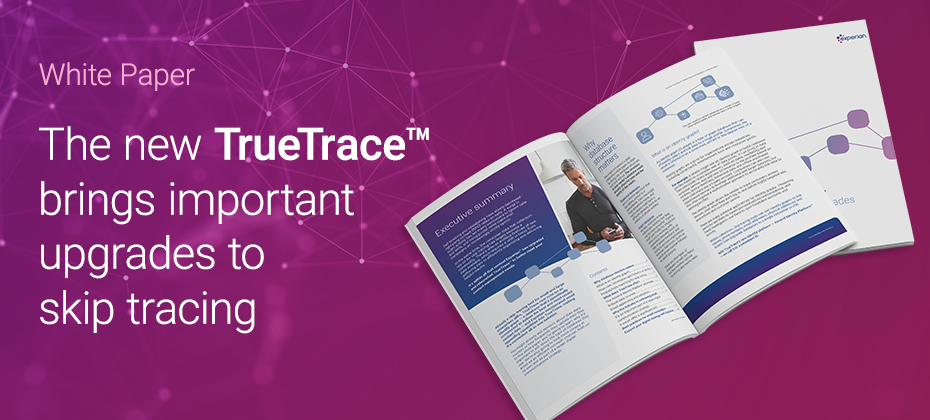Latest Posts

In the latest episode of “The Chrisman Commentary” podcast, Experian experts Joy Mina, Director of Product Commercialization, and David Fay, Solution Consultant, talk about reducing mortgage pipeline fallout and improving loan pull-through rate. Listen to the full episode for all the details and check out the previous episode to explore how lenders can navigate a tight mortgage market, from rates to equity. Listen to podcast

In today's fast-paced world, the ability to locate individuals quickly and accurately is crucial for debt collectors and lenders. Leading skip tracing software is differentiated by data accuracy and data source expansion that delivers increased right-party contact (RPC) rates, better cost efficiency, and improved user experience. The need for improved skip tracing The landscape of skip tracing has changed dramatically in recent years. Call blocking and mislabeling have led to a decline in RPC rates, while increased scam activity has caused many consumers to ignore calls and texts. Additionally, the sheer volume of new information available makes efficiently organizing and delivering helpful results a higher priority than simply gathering data. Here are a few quick stats: Email addresses go stale at a rate of 3% each month There are 820 million changes across all contact databases every 90 days Human errors lead to 50% of data issues, such as a typo that results in a bounced email[1] As a result, we’ve made significant improvements to our skip tracing solution, TrueTrace™. What is TrueTrace? TrueTrace, a powerful skip tracing solution, is a go-to resource for both small and enterprise collectors. For locating hard-to-find individuals, TrueTrace is now even more effective, leveraging advanced technology and more data to enhance its performance. Some organizations that tested TrueTrace saw a 10% lift in RPC rates compared to the competition.[2] Here’s a look at some of the improvements we’ve made: Enhanced data accuracy: TrueTrace now runs on an identity graph to tie data from disparate sources to a unique persistent ID for each consumer. This upgrade improves data matching and accuracy, ensuring that users can rely on the information provided. Expanded data sources: The new version of TrueTrace incorporates email appending, making it a convenient all-in-one solution. By including new and unique data sources, TrueTrace increases hit rates and provides more quality results. With these improvements, here are some potential benefits to your business: Increased RPC rates: Improved data quality and accuracy lead to higher RPC rates, making it easier for collectors to reach the right individuals. Cost efficiency: Reducing operational costs associated with wrong-party contacts and outdated information helps businesses save money and improve their bottom line. Improved user experience: Easier access to accurate data leads to more efficient operations and a better overall user experience. Using an identity graph to organize data points Identity graphs allow organizations to build customer profiles based on a combination of data points. Companies can also use cloud-based services to implement additional, larger sets of data. Within an outreach strategy, skip tracing tools can use identity graphs to associate names, phone numbers, email address, physical address, and assets from multiple, unrelated databases into a single source of accurate information. This can help organizations save time and increase efficiency. Upgrades to skip tracing help businesses enhance efficiency The latest enhancements to TrueTrace represent a significant advancement in skip tracing technology. With upgraded data accuracy, expanded data sources, real-time updates, and flexible integration, TrueTrace offers a comprehensive solution for businesses looking to improve their outreach strategy. This tool can help businesses achieve higher RPC rates, reduce costs, and enhance their overall operational efficiency. To learn more about TrueTrace and its new features, read our latest whitepaper or visit our website or contact us for further inquiries. Discover how TrueTrace can help your business achieve better skip tracing with higher quality results today. Read the whitepaper Visit our website [1] Experian (2023). Revolutionizing your email strategy. [2] Experian TrueTrace data

As consumer credit behaviors change, staying informed is crucial for credit unions. Experian’s new State of Credit Unions Report offers a comprehensive analysis of consumer credit trends from January 2022 to October 2024, with a particular focus on auto loans, unsecured personal loans and unsecured credit cards. The report covers: Trends in originations and delinquencies among credit union members How credit unions fare against other fintech lenders and regional banks Strategies to attract new members and mitigate portfolio risk Discover key insights into the consumer credit landscape and how credit unions stack up against other financial institutions. Download the report

In today's fast-paced financial landscape, demand deposit accounts (DDAs) have become a cornerstone for both consumers and financial institutions. These accounts, which include checking, savings, and money market accounts, offer the flexibility of accessing funds on demand without prior notice. As the financial industry evolves, the demand for consumer DDAs continues to grow, driven by the need for convenient and accessible banking solutions. Why DDAs are critical for financial institutions As a financial institution, consumer DDAs are crucial for you for several reasons: Customer Acquisition and Retention: DDAs can serve as the first point of contact between customers and financial institutions. By offering attractive DDA options, you can attract new customers and retain existing ones, fostering long-term relationships. Revenue Streams: DDAs generate revenue through various channels like interest on account balances, and also provide opportunities for cross-selling other financial products and services, enhancing overall profitability. Data Insights: DDAs offer valuable insights into customer behavior and spending patterns. Financial institutions can leverage this data to tailor their products and services, improve customer satisfaction, and develop targeted marketing strategies. Liquidity Management: DDAs help you manage liquidity by providing a stable source of low-cost funds. The deposits in these accounts can be used to support lending activities and other financial operations, ensuring your financial stability. These points highlight the strategic importance of consumer DDAs in the overall business model of financial institutions, making them a critical component for success. Attracting and retaining Gen Z and millennial customers Gen Z and Millennials are more likely to change financial institutions frequently. Capturing this audience is essential, as Gen Z will likely be the largest and wealthiest generation in the future. Members of this generation value digital capabilities, personalized experiences, and flexibility, often switching banks to find better services and offers. Over 40% of Gen Z switched financial institutions between 2023-2024 1. A few strategies for attracting and retaining these critical generations include: Digital-First Approach: Both Gen Z and Millennials have grown up with technology and expect seamless digital experiences. Offering robust online and mobile banking platforms with features like digital account opening, real-time transaction alerts, and easy fund transfers is crucial. Credit Card Cross-sell Opportunities: Among Gen Z and Millennials, credit cards continue to be the most in-demand banking product2. By pairing attractive DDA offers with compelling credit cards, you can pave the way for DDA opportunities with current card-only customers. Personalization: These generations value personalized experiences. You can use advanced data analytics to offer customized financial products and services that meet individuals’ needs and preferences. Personalized communication and tailored offers can significantly enhance customer satisfaction and loyalty. Financial Education and Tools: Providing educational resources and tools to help manage finances can be a significant draw. Gen Z and Millennials appreciate institutions that offer budgeting tools, financial literacy programs, and personalized financial advice, and are likely to stick with institutions that also act as a trusted advisor. Innovative Features: Offering innovative features like integration with digital wallets, buy-now-pay-later options, and family banking tools can appeal to the tech-savvy nature of these generations. Keeping up with the latest technology trends ensures that the institution remains relevant and attractive. What consumers want in a demand deposit account With today’s high-interest rates and digital banking services, consumers are willing and able to move their money now more than ever. It’s important to understand what a consumer values in a DDA to stay competitive: Accessibility and Convenience: Consumers want easy access to their funds at any time, whether through ATMs, online banking, or mobile apps. The ability to manage their accounts and perform transactions seamlessly is a top priority3. Interest Earnings: While not all demand deposit accounts offer interest, many consumers appreciate the opportunity to earn interest on their balances. This feature can make a DDA more attractive compared to non-interest-bearing accounts3. Security and Fraud Protection: Security is paramount for consumers. They want assurance that their funds are protected against fraud and unauthorized access, with features like real-time alerts and robust fraud detection systems3. These features collectively enhance the appeal of demand deposit accounts, making them more attractive to consumers seeking reliable and efficient banking solutions. How Experian Partner Solutions can help We offer a suite of tools and services designed to help financial institutions attract and retain your DDA customers: Advanced Data Analytics: We leverage extensive data analytics to understand consumer behavior and preferences. This allows you to create highly targeted and personalized offers that resonate with potential customers. Personalized Financial Insights: By leveraging comprehensive financial data, we can help you offer personalized insights and action plans that help customers manage their finances more effectively. This personalized approach can significantly enhance customer satisfaction and loyalty. Identity Monitoring: Our credit and identity alerts empower your consumers to spot potential fraud, assess risks, and respond before they become a victim of identity theft. By personalizing these alerts, we can drive consumers to your portal to review their risk level and respond in real time, giving you opportunities through additional touchpoints. Financial Wellness Solutions: We offer comprehensive credit and financial management tools to help your customers better understand the credit environment and learn how they can most effectively manage their finances. Educated, financially healthier customers are less likely to miss payments and ultimately pose less risk to your business. By utilizing these capabilities, we can help you attract and retain customers for DDA accounts, ultimately driving growth and enhancing customer satisfaction. The demand for consumer DDAs is on the rise, driven by the need for accessible and flexible banking solutions. Financial institutions like credit unions and banks attract new deposits by offering competitive interest rates, seamless digital banking experiences, and personalized financial products. As consumers seek more convenience and value, financial institutions must innovate to meet evolving expectations and retain deposit growth. We offer the tools and insights needed to navigate this evolving landscape, helping you thrive in a competitive market. This article includes content created by an AI language model and is intended to provide general information. References [1] Why Gen Z is Switching Banks | Chime [2] 2025 Will Be the Year of the Credit Card | The Financial Brand [3] What Is a Demand Deposit Account? | Banking Advice | U.S. News

With cybersecurity threats on the rise, organizations are turning to token-based authentication as a secure and efficient solution to safeguard sensitive data and systems. Data breaches impacted 1.1 billion individuals in 2024, a staggering 490% increase from the previous year.1 Token-based authentication is a method of verifying a user's identity through digital tokens rather than traditional means such as passwords. These tokens are temporary and serve as access keys, allowing users to securely interact with systems, applications, and networks. The goal of token authentication is to strengthen security while improving the user experience. Instead of relying solely on static credentials (like passwords), which can be intercepted or stolen, leveraging a type of multi-factor authentication like tokens adds an additional layer of security by functioning as dynamic access credentials. How token-based authentication works Token authentication unfolds through a series of steps to ensure robust security. Here's a simplified breakdown of how it works in practice: User request and authentication: When a user attempts to log in, they provide their credentials (e.g., username and password). These credentials are verified by the authentication server. Token generation: After verifying the user's credentials, the server generates a token — a cryptographically secured string often containing information like the user's ID and permissions. Token sent to the user: The generated token is sent back to the user or their device to confirm authentication. Token usage for access: Now authenticated, the user uses the token to access the system or application. The token is passed along with each request to ensure the user is authorized to proceed. Token validation: Each time a token is presented to the server, its integrity and expiration are verified. If the token is valid, access is granted; if not, the session is terminated. Token expiration and renewal: Tokens are typically temporary and expire after a set period. Users must either re-authenticate or renew the token for continued access. This limits the time window during which a stolen token can be misused. Types of token authentication methods Token authentication comes in different forms to meet various use case requirements. Common types include: JSON Web Tokens (JWT) Lightweight, self-contained, and easily transferred between clients and servers, JWT is one of the most widely used token formats. It includes claims, which are bits of information about a user encoded within the token, such as roles and permissions. Example: A financial application uses JWTs to ensure only registered users can access private account data. OAuth tokens OAuth is an industry-standard authorization protocol that uses tokens to grant limited access to applications without revealing the user's credentials. It’s often used for third-party service integration. Example: When you log into an e-commerce platform using your Google credentials, OAuth tokens authorize access. Session tokens These are temporary tokens stored on the server to track authenticated sessions, commonly used in web applications to ensure secure browsing. Example: Online banking platforms rely on session tokens for secure user sessions. Refresh tokens Refresh tokens are designed to renew access tokens without requiring the user to log in repeatedly. They extend session durations while maintaining a high-security standard. Example: A subscription service app uses refresh tokens to maintain a seamless user experience without frequent logouts. Benefits of token-based authentication Token-based authentication offers several advantages that make it a preferred security measure for organizations of all sizes. Enhanced security: Tokens reduce the risk of breaches as they are temporary and encrypted. They’re also specific to sessions, applications, or devices, meaning unauthorized users cannot reuse stolen tokens effectively. Elimination of password reliance: Tokens reduce dependence on static passwords, which are often reused and susceptible to brute-force attacks. This bolsters an organization’s overall cybersecurity posture. Improved user experience: Token authentication allows for more seamless interactions by minimizing the need for repeated logins. With features like single sign-on (SSO), users enjoy convenient access to multiple platforms with a single token. Scalability: Tokens are flexible and can adapt to varied business use cases, making them ideal for organizations of all scales. For instance, application programming interfaces (APIs) and microservices can communicate securely via token exchanges. Supports compliance: Token-based authentication helps organizations meet regulatory compliance requirements by offering robust access control and audit trails. This is critical for industries like finance, healthcare, and e-commerce. Cost efficiency: While implementing token-based authentication may require an initial investment, it reduces long-term risks and costs associated with data breaches, system downtime, and customer trust. How Experian can help strengthen your authentication process At Experian, we recognize that strong security measures should never compromise the user experience. That's why we offer cutting-edge identity solutions tailored to meet the needs of organizations. Our tools allow you to integrate token-based authentication seamlessly into your systems while ensuring compliance with security best practices and industry regulations. Are you ready to take your business's security and user experience to the next level? Visit us online today. Learn more 12024-2025 Data Breach Response Guide, Experian, 2024. This article includes content created by an AI language model and is intended to provide general information.

The financial services industry faces increasing pressure to innovate in today's fluctuating interest rate environment. For regional banks and credit unions, effective deposit growth strategies involve more than just offering attractive rates. Leveraging data and analytics is key to enhancing deposit portfolios, improving customer engagement, and fostering financial wellness. By prioritizing consumer-focused solutions, institutions can achieve dual benefits: driving organizational growth while meeting customer needs. For a deeper dive into this subject, check out our on-demand webinar “Growing Beyond Interest Rates: The Opportunity for Demand Deposit Accounts.” The current state of interest rates and market dynamics As interest rates change, financial institutions encounter shrinking margins and heightened competition. The stakes are high: 54% of consumers plan to leave their banks within the next year1, often citing unmet expectations for personalized services and financial guidance2. This competitive environment requires innovative strategies to retain customers and attract new ones without solely relying on interest rates. Key challenges: Shrinking margins due to rate volatility. Increased competition from fintechs and alternative providers. Rising consumer expectations for personalized, proactive services. Leveraging data and analytics in your deposit growth strategies Regional banks and credit unions can distinguish themselves by investing in advanced data analytics and personalized engagement tools. These strategies help create value for customers while improving the institution’s operational efficiency and revenue potential. 1. Personalization through financial insights According to Experian data, more than half of consumers expect their financial provider to actively support their financial wellness2. However, one-third feel that current efforts fall short3. Offering tools like spending trackers, budgeting resources, and personalized credit score improvement plans can help close this gap. 2. Engagement-driven solutions Consumers are more likely to stay loyal to institutions that provide actionable insights. Experian’s partners have seen a 5% lift in 12-month retention rates among customers enrolled in credit and identity programs according to data reported by partners2. Alerts for credit monitoring and financial updates not only keep customers informed but also help drive monthly logins, enhancing cross-sell opportunities. 3. Identity and data protection as value-added services With the increasing threat of identity theft, proactive identity monitoring and restoration services are becoming critical. Banks offering these features—branded under their name—can boost customer satisfaction and loyalty. Practical steps for regional banks and credit unions To capitalize on these opportunities, financial institutions should consider the following steps: Step 1: Develop a customer-centric engagement program Tailor programs to different demographic groups. Millennials and Gen Z are particularly drawn to tech-savvy solutions that integrate seamlessly with their financial lives. By consolidating financial management tools within one portal, banks can help simplify customers’ lives and enhance engagement. Step 2: Focus on retention and cross-sell opportunities Consumers engaged with financial tools, such as credit score trackers or budgeting aids, exhibit stronger loyalty and are more likely to adopt additional products. Use insights from these tools to offer personalized product recommendations that align with their financial journey. Step 3: Offer premium tiers Institutions can create tiered service packages, starting with free offerings (e.g., basic credit monitoring) and progressing to paid premium packages that include advanced identity protection or financial management analytics. Step 4: Utilize advanced analytics for targeting By analyzing anonymized customer data, banks can identify high-value segments and tailor marketing efforts to their specific needs. This targeted approach fosters more meaningful relationships and improves ROI on acquisition campaigns. Case for Action: Why consumer engagement matters A customer engagement program does more than enhance loyalty, it helps drive measurable outcomes: Retention rates: Over 98% for free services and 91% for paid programs.4 Improved credit scores: Subprime consumers enrolled in credit-building tools see an average credit score increase of 32 points.5 Higher satisfaction scores: Some institutions offering comprehensive financial tools report a lift in Net Promoter Scores (NPS). Conclusion The path forward for regional banks and credit unions lies in moving beyond rate-based competition and looking to multipronged deposit growth strategies. By leveraging data, analytics, and consumer-focused programs, financial institutions can enhance their deposit portfolios and deepen customer relationships. Now is the time to transform engagement into a growth engine, ensuring long-term success in a dynamic market. Ready to elevate your deposit portfolio with our tailored solutions? Click below to learn more or contact us to schedule a consultation and design a program that meets your organization’s goals. Learn more Watch the webinar 1 Retail Bank Customer Satisfaction Holds Steady but Trust Declines, J.D. Power Finds, 2024 2 Experian internal analysis, 2024 3 MX, What Influences Where Consumers Choose to Bank, June 2023 4 Experian Core metrics analysis, October 2023 5 Experian Data, Credit Score Rates with subprime consumers, June 2022 – June 2023

As Valentine’s Day approaches, hearts will melt, but some will inevitably be broken by romance scams. This season of love creates an opportune moment for scammers to prey on individuals feeling lonely or seeking connection. Financial institutions should take this time to warn customers about the heightened risks and encourage vigilance against fraud. In a tale as heart-wrenching as it is cautionary, a French woman named Anne was conned out of nearly $855,000 in a romance scam that lasted over a year. Believing she was communicating with Hollywood star Brad Pitt; Anne was manipulated by scammers who leveraged AI technology to impersonate the actor convincingly. Personalized messages, fabricated photos, and elaborate lies about financial needs made the scam seem credible. Anne’s story, though extreme, highlights the alarming prevalence and sophistication of romance scams in today’s digital age. According to the Federal Trade Commission (FTC), nearly 70,000 Americans reported romance scams in 2022, with losses totaling $1.3 billion—an average of $4,400 per victim. These scams, which play on victims’ emotions, are becoming increasingly common and devastating, targeting individuals of all ages and backgrounds. Financial institutions have a crucial role in protecting their customers from these schemes. The lifecycle of a romance scam Romance scams follow a consistent pattern: Feigned connection: Scammers create fake profiles on social media or dating platforms using attractive photos and minimal personal details. Building trust: Through lavish compliments, romantic conversations, and fabricated sob stories, scammers forge emotional bonds with their targets. Initial financial request: Once trust is established, the scammer asks for small financial favors, often citing emergencies. Escalation: Requests grow larger, with claims of dire situations such as medical emergencies or legal troubles. Disappearance: After draining the victim’s funds, the scammer vanishes, leaving emotional and financial devastation in their wake. Lloyds Banking Group reports that men made up 52% of romance scam victims in 2023, though women lost more on average (£9,083 vs. £5,145). Individuals aged 55-64 were the most susceptible, while those aged 65-74 faced the largest losses, averaging £13,123 per person. Techniques scammers use Romance scammers are experts in manipulation. Common tactics include: Fabricated sob stories: Claims of illness, injury, or imprisonment. Investment opportunities: Offers to “teach” victims about investing. Military or overseas scenarios: Excuses for avoiding in-person meetings. Gift and delivery scams: Requests for money to cover fake customs fees. How financial institutions can help Banks and financial institutions are on the frontlines of combating romance scams. By leveraging technology and adopting proactive measures, they can intercept fraud before it causes irreparable harm. 1. Customer education and awareness Conduct awareness campaigns to educate clients about common scam tactics. Provide tips on recognizing fake profiles and unsolicited requests. Share real-life stories, like Anne’s, to highlight the risks. 2. Advanced data capture solutions Implement systems that gather and analyze real-time customer data, such as IP addresses, browsing history, and device usage patterns. Use behavioral analytics to detect anomalies in customer actions, such as hesitation or rushed transactions, which may indicate stress or coercion. 3. AI and machine learning Utilize AI-driven tools to analyze vast datasets and identify suspicious patterns. Deploy daily adaptive models to keep up with emerging fraud trends. 4. Real-time fraud interception Establish rules and alerts to flag unusual transactions. Intervene with personalized messages before transfers occur, asking “Do you know and trust this person?” Block transactions if fraud is suspected, ensuring customers’ funds are secure. Collaborating for greater impact Financial institutions cannot combat romance scams alone. Partnerships with social media platforms, AI companies, and law enforcement are essential. Social media companies must shut down fake profiles proactively, while regulatory frameworks should enable banks to share information about at-risk customers. Conclusion Romance scams exploit the most vulnerable aspects of human nature: the desire for love and connection. Stories like Anne’s underscore the emotional and financial toll these scams take on victims. However, with robust technological solutions and proactive measures, financial institutions can play a pivotal role in protecting their customers. By staying ahead of fraud trends and educating clients, banks can ensure that the pursuit of love remains a source of joy, not heartbreak. Learn more

Debt collectors face a multitude of challenges when it comes to contacting the right people at the right time and improving their processes for collections. We interviewed Matt Baltzer, Senior Product Management Director at Experian, to learn more about how his team is helping debt collectors engage their customers and optimize their collection strategies.

As data breaches become an ever-growing threat to businesses, the role of employees in maintaining cybersecurity has never been more critical. Did you know that 82% of data breaches involve the human element1 , such as phishing, stolen credentials, or social engineering tactics? These statistics reveal a direct connection between employee identity theft and business vulnerabilities. In this blog, we’ll explore why protecting your employees’ identities is essential to reducing data breach risk, how employee-focused identity protection programs, and specifically employee identity protection, improve both cybersecurity and employee engagement, and how businesses can implement comprehensive solutions to safeguard sensitive data and enhance overall workforce well-being. The Rising Challenge: Data Breaches and Employee Identity Theft The past few years have seen an exponential rise in data breaches. According to the Identity Theft Resource Center, there were 1,571 data compromises in the first half of 2024, impacting more than 1.1 billion individuals – a 490% increase year over year2. A staggering proportion of these breaches originated from compromised employee credentials or phishing attacks. Explore Experian's Employee Benefits Solutions The Link Between Employee Identity Theft and Cybersecurity Risks Phishing and Social EngineeringPhishing attacks remain one of the top strategies used by cybercriminals. These attacks often target employees by exploiting personal information stolen through identity theft. For example, a cybercriminal who gains access to an employee's compromised email or social accounts can use this information to craft realistic phishing messages, tricking them into divulging sensitive company credentials. Compromised Credentials as Entry PointsCompromised employee credentials were responsible for 16% of breaches and were the costliest attack vector, averaging $4.5 million per breach3. When an employee’s identity is stolen, it can give hackers a direct line to your company’s network, jeopardizing sensitive data and infrastructure. The Cost of DowntimeBeyond the financial impact, data breaches disrupt operations, erode customer trust, and harm your brand. For businesses, the average downtime from a breach can last several weeks – time that could otherwise be spent growing revenue and serving clients. Why Businesses Need to Prioritize Employee Identity Protection Protecting employee identities isn’t just a personal benefit – it’s a strategic business decision. Here are three reasons why identity protection for employees is essential to your cybersecurity strategy: 1. Mitigate Human Risk in Cybersecurity Employee mistakes, often resulting from phishing scams or misuse of credentials, are a leading cause of breaches. By equipping employees with identity protection services, businesses can significantly reduce the likelihood of stolen information being exploited by fraudsters and cybercriminals. 2. Boost Employee Engagement and Financial Wellness Providing identity protection as part of an employee benefits package signals that you value your workforce’s security and well-being. Beyond cybersecurity, offering such protections can enhance employee loyalty, reduce stress, and improve productivity. Employers who pair identity protection with financial wellness tools can empower employees to monitor their credit, secure their finances, and protect against fraud, all of which contribute to a more engaged workforce. 3. Enhance Your Brand Reputation A company’s cybersecurity practices are increasingly scrutinized by customers, stakeholders, and regulators. When you demonstrate that you prioritize not just protecting your business, but also safeguarding your employees’ identities, you position your brand as a leader in security and trustworthiness. Practical Strategies to Protect Employee Identities and Reduce Data Breach Risk How can businesses take actionable steps to mitigate risks and protect their employees? Here are some best practices: Offer Comprehensive Identity Protection Solutions A robust identity protection program should include: Real-time monitoring for identity theft Alerts for suspicious activity on personal accounts Data and device protection to protect personal information and devices from identity theft, hacking and other online threats Fraud resolution services for affected employees Credit monitoring and financial wellness tools Leading providers like Experian offer customizable employee benefits packages that provide proactive identity protection, empowering employees to detect and resolve potential risks before they escalate. Invest in Employee Education and Training Cybersecurity is only as strong as your least-informed employee. Provide regular training sessions and provide resources to help employees recognize phishing scams, understand the importance of password hygiene, and learn how to avoid oversharing personal data online. Implement Multi-Factor Authentication (MFA) MFA adds an extra layer of security, requiring employees to verify their identity using multiple credentials before accessing sensitive systems. This can drastically reduce the risk of compromised credentials being misused. Partner with a Trusted Identity Protection Provider Experian’s suite of employee benefits solutions combines identity protection with financial wellness tools, helping your employees stay secure while also boosting their financial confidence. Only Experian can offer these integrated solutions with unparalleled expertise in both identity protection and credit monitoring. Conclusion: Identity Protection is the Cornerstone of Cybersecurity The rising tide of data breaches means that businesses can no longer afford to overlook the role of employee identity in cybersecurity. By prioritizing identity protection for employees, organizations can reduce the risk of costly breaches and also create a safer, more engaged, and financially secure workforce. Ready to protect your employees and your business? Take the next step toward safeguarding your company’s future. Learn more about Experian’s employee benefits solutions to see how identity protection and financial wellness tools can transform your workplace security and employee engagement. Learn more 1 2024 Experian Data Breach Response Guide 2 Identity Theft Resource Center. H1 2024 Data Breach Analysis 3 2023 IBM Cost of a Data Breach Report

Picture this: you’re sipping your morning coffee when an urgent email from your CEO pops up in your inbox, requesting sensitive information. Everything about it seems legit — their name, email address, even their usual tone. But here’s the twist: it’s not actually them. This is the reality of spoofing attacks. And these scenarios aren’t rare. According to the Federal Bureau of Investigation (FBI), spoofing/phishing is the most common type of cybercrime.¹ In these attacks, bad actors disguise their identity to trick individuals or systems into believing the communication is from a trusted source. Whether it’s email spoofing, caller ID spoofing, or Internet Protocol (IP) spoofing, the financial and reputational consequences can be severe. By understanding how these attacks work and implementing strong defenses, organizations can reduce their risk and protect sensitive information. Let’s break down the key strategies for staying one step ahead of cybercriminals. What is a spoofing attack? A spoofing attack occurs when a threat actor impersonates a trusted source to gain access to sensitive information, disrupt operations or manipulate systems. Common types of spoofing attacks include: Email spoofing: Fraudulent emails are carefully crafted to mimic legitimate senders, often including convincing details like company logos, real employee names, and professional formatting. These emails trick recipients into sharing sensitive information, such as login credentials or financial details, or prompt them to download malware disguised as attachments. For example, attackers might impersonate a trusted vendor to redirect payments or a senior executive requesting immediate access to confidential data. Caller ID spoofing: Attackers manipulate phone numbers to impersonate trusted contacts, making calls appear as if they are coming from legitimate organizations or individuals. This tactic is often used to extract sensitive information, such as account credentials, or to trick victims into making payments. For instance, a scammer might pose as a bank representative calling to warn of suspicious activity on an account, coercing the recipient into sharing private information or transferring funds. IP spoofing: IP addresses are falsified to disguise the origin of malicious traffic to bypass security measures and mask malicious activity. Cybercriminals use this method to redirect traffic, conduct man-in-the-middle attacks, where a malicious actor intercepts and possibly alters the communication between two parties without their knowledge, or overwhelm systems with distributed denial-of-service (DDoS) attacks. For example, attackers might alter the source IP address of a data packet to appear as though it is coming from a trusted source, making it easier to infiltrate networks and compromise sensitive data. These tactics are often used in conjunction with other cyber threats, such as phishing or bot fraud, making detection and prevention more challenging. How behavioral analytics can combat spoofing attacks Traditional fraud prevention methods provide a strong foundation but behavioral analytics adds a powerful layer to fraud stacks. By examining user behavior patterns, behavioral analytics enhances existing tools to: Detect anomalies that signal a spoofing attack. Identify bot fraud attempts, where automated scripts mimic legitimate users. Enhance fraud prevention solutions with friction-free, real-time insights. Behavioral analytics is particularly effective when paired with device and network intelligence and machine learning (ML) solutions. These advanced tools can continuously adapt to new fraud tactics, ensuring robust protection against evolving threats. The role of artificial intelligence (AI) and ML in spoofing attack prevention AI fraud detection is revolutionizing how organizations protect themselves from spoofing attacks. By leveraging AI analytics and machine learning solutions, organizations can: Analyze vast amounts of data to identify spoofing patterns. Automate threat detection and response. Strengthen overall fraud prevention strategies. These technologies are essential for staying ahead of cybercriminals, particularly as they increasingly use AI to perpetrate attacks. Best practices for preventing spoofing attacks Organizations can take proactive steps to minimize the risk of spoofing attacks. Key strategies include: Implementing robust authentication protocols: Use multifactor authentication (MFA) to verify the identity of users and systems. Monitoring network traffic: Deploy tools that can analyze traffic for signs of IP spoofing or other anomalies. Leveraging behavioral analytics: Adopt advanced fraud prevention solutions that include behavioral analytics to detect and mitigate threats. Educating employees: Provide training on recognizing phishing attempts and other spoofing tactics. Partnering with fraud prevention experts: Collaborate with trusted providers like Experian to access cutting-edge solutions tailored to your needs. Why proactive prevention matters The financial and reputational damage caused by spoofing attacks can be devastating. Organizations that fail to implement effective prevention measures risk: Losing customer trust. Facing regulatory penalties. Incurring significant financial losses. Businesses can stay ahead of cyber threats by prioritizing spoofing attack prevention and leveraging advanced technologies such as behavioral analytics, AI fraud detection, and machine learning, Investing in fraud prevention solutions today is essential for protecting your organization’s future. How we help organizations detect spoofing attacks Spoofing attacks are an ever-present danger in the digital age. With tactics like IP spoofing and bot fraud becoming more sophisticated, businesses must adopt advanced strategies to safeguard their operations. Our comprehensive suite of fraud prevention solutions can help businesses tackle spoofing attacks and other cyber threats. Our advanced technologies like behavioral analytics, AI fraud detection and machine learning solutions, enable organizations to: Identify and respond to spoofing attempts in real-time. Detect anomalies and patterns indicative of fraudulent behavior. Strengthen defenses against bot fraud and IP spoofing. Ensure compliance with industry regulations and standards. Click ‘learn more’ below to explore how we can help protect your organization. Learn more 1 https://www.ic3.gov/AnnualReport/Reports/2023_IC3Report.pdf This article includes content created by an AI language model and is intended to provide general information.

Financial identity theft is one of the biggest threats to a consumer’s financial wellness in today’s digital age.1 It occurs when someone steals their personal and financial information, such as their name, address, Social Security Number (SSN), credit card, or bank account numbers, and uses it to make unauthorized purchases or access their financial accounts without their permission. This can severely damage their credit score and financial standing, often taking significant time and effort to resolve. Financial identity theft can also harm organizations, taking a toll on bottom lines due to lost employee productivity and more severe consequences if the stolen identity exposes the organization to a data breach. How financial identity theft happens Financial identity theft can occur through various methods, including: Skimming: Thieves use skimming devices at ATM machines or gas pumps to steal credit or debit card information. These devices can be hard to detect, making it easy for thieves to capture card details without the owner's knowledge. Phishing: Scammers send emails or text messages that appear to be from a bank or other financial institution, asking for personal information. These messages often look legitimate, tricking consumers into providing sensitive data. Social engineering: Thieves impersonate someone in authority to trick consumers into giving them their personal or financial information. This can happen over the phone, in person, or through digital communication. Data breaches: Hackers gain access to large databases of personal and financial information through breaches at companies or organizations. This stolen data can then be sold or used to commit identity theft. Stealing mail: Thieves steal mail from mailboxes or trash cans to obtain personal financial information. This can include bank statements, credit card offers, and other documents containing sensitive data. Account takeover: Thieves use stolen personal information to access existing financial accounts. They can change account details, make unauthorized transactions, and even open new accounts, causing significant financial damage. Protecting consumers from financial identity theft Organizations play a crucial role in protecting their consumers from financial identity theft. A few strategies that organizations and financial institutions can implement to protect their customers include: Implement strong authentication methods: Use multi-factor authentication (MFA) to add an extra layer of security. This requires users to provide two or more verification factors to gain access to their accounts, significantly reducing the risk of unauthorized access. Educate consumers: Offer services to educate consumers about the risks of identity theft and provide tips on protecting their personal information. This includes advising them to use strong, unique passwords and to be cautious of phishing scams. Monitor for suspicious activity: Use advanced monitoring systems to detect unusual activity in consumer accounts. This can help identify potential fraud early, ensuring that any threats are addressed before they cause significant harm. Provide identity theft protection services: Offer services that monitor consumers' credit reports and alert them to suspicious activity. These services provide continuous oversight, helping consumers stay informed and protected against potential identity theft. Why prioritizing financial wellness matters Investing in your customers' financial wellness not only benefits them but also brings significant advantages to your organization. Some key benefits of helping your customers improve their financial wellness include: Increased customer loyalty: Investing in your customers' financial wellness builds trust and strengthens your relationship, leading to higher customer retention and loyalty. Reduced customer delinquency: Educating your customers on financial management can lead to fewer missed payments and defaults, reducing your risk and improving overall financial stability. Higher customer engagement: Providing financial wellness resources and tools encourages your customers to engage more frequently with your organization, fostering a deeper connection. Competitive advantage: Offering financial wellness programs can differentiate you from your competitors, making you more attractive to potential customers who value financial education and support. Positive social impact: By helping your customers improve their financial health, you contribute to the overall economic well-being of the community, creating a positive social impact. Reduced risk of data breach: Compromised employee credentials are one of the most common gateways for data breaches. By educating consumers on protecting their financial well-being, you also protect your organization from data breach threats. Experian Partner Solutions: Protecting your customers We offer a range of tools to help you support your customers on their financial wellness journey and defend against bad actors. With our partnership, you can offer your customers access to: Credit and identity monitoring and alerts: Keep consumers engaged with reliable credit tools that monitor their credit reports and personal information to alert them of potential threats, such as dark web exposure or suspicious activity. Our advanced monitoring systems provide real-time alerts, helping your consumers take immediate action to protect their financial health. Identity restoration: Provide peace of mind by helping your consumers reclaim their identity if they fall victim to identity theft. Our dedicated identity restoration specialists guide consumers through recovery, ensuring they regain control of their financial identity quickly and efficiently. Data breach resolution: Manage consumer data breach and crisis incidents confidently, helping to mitigate the impact on affected individuals. We offer comprehensive breach response services, including notification, monitoring, and support, to help organizations handle breaches effectively and maintain consumer trust. Credit education: Empower consumers with the knowledge and tools to understand and improve their credit health, building customer loyalty and supporting their journey towards better financial wellness. Our educational resources and personalized advice enable consumers to make informed financial decisions and achieve their financial goals. Protecting against financial identity theft requires a collaborative effort between consumers and organizations. By partnering with us, you can offer comprehensive financial and identity protection solutions that engage, educate, and empower your customers to better manage their financial lives. This not only helps protect your customers, but also builds trust and loyalty, positioning your organization as a trusted advocate in financial wellness and identity protection. Learn more View infographic 1Identity Theft Resource Center, Consumer Aftermath Report. This article includes content created by an AI language model and is intended to provide general information.

In today's fast-paced financial landscape, consumer expectations are higher than ever. Financial institutions must rethink their strategies to stay ahead of rising interest rates, intense competition, and the need to innovate constantly. To thrive, it’s not just about offering the best rates—it's about building deeper, more meaningful relationships with customers and delivering personalized, proactive value that drives loyalty and growth.

With the National Automobile Dealers Association (NADA) Show set to kickoff later this week, it seemed fitting to explore how the shifting dynamics of the used vehicle market might impact dealers and buyers over the coming year. Shedding light on some of the registration and finance trends, as well as purchasing behaviors, can help dealers and manufacturers stay ahead of the curve. And just like that, the Special Report: Automotive Consumer Trends Report was born. As I was sifting through the data, one of the trends that stood out to me was the neck-and-neck race between Millennials and Gen X for supremacy in the used vehicle market. Five years ago, in 2019, Millennials were responsible for 33.3% of used retail registrations, followed by Gen X (29.5%) and Baby Boomers (26.8%). Since then, Baby Boomers have gradually fallen off, and Gen X continues to close the already minuscule gap. Through October 2024, Millennials accounted for 31.6%, while Gen X accounted for 30.4%. But trends can turn on a dime if the last year offers any indication. Over the last rolling 12 months (October 2023-October 2024), Gen X (31.4%) accounted for the majority of used vehicle registrations compared to Millennials (30.9%). Of course, the data is still close, and what 2025 holds is anyone’s guess, but understanding even the smallest changes in market share and consumer purchasing behaviors can help dealers and manufacturers adapt and navigate the road ahead. Although there are similarities between Millennials and Gen X, there are drastic differences, including motivations and preferences. Dealers and manufacturers should engage them on a generational level. What are they buying? Some of the data might not come as a surprise but it’s a good reminder that consumers are in different phases of life, meaning priorities change. Over the last rolling 12 months, Millennials over-indexed on used vans, accounting for more than one-third of registrations. Meanwhile, Gen X over-indexed on used trucks, making up nearly one-third of registrations, and Gen Z over-indexed on cars (accounting for 17.1% of used car registrations compared to 14.6% of overall used vehicle registrations). This isn’t surprising. Many Millennials have young families and may need extra space and functionality, while Gen Xers might prefer the versatility of the pickup truck—the ability to use it for work and personal use. On the other hand, Gen Zers are still early in their careers and gravitate towards the affordability and efficiency of smaller cars. Interestingly, although used electric vehicles only make up a small portion of used retail registrations (less than 1%), Millennials made up nearly 40% over the last rolling 12 months, followed by Gen X (32.2%) and Baby Boomers (15.8%). The market at a bird’s eye view Pulling back a bit on the used vehicle landscape, over the last rolling 12 months, CUVs/SUVs (38.9%) and cars (36.6%) accounted for the majority of used retail registrations. And nearly nine-in-ten used registrations were non-luxury vehicles. What’s more, ICE vehicles made up 88.5% of used retail registrations over the same period, while alternative-fuel vehicles (not including BEVs) made up 10.7% and electric vehicles made up 0.8%. At the finance level, we’re seeing the market shift ever so slightly. Since the beginning of the pandemic, one of the constant narratives in the industry has been the rising cost of owning a vehicle, both new and used. And while the average loan amount for a used non-luxury vehicle has gone up over the past five years, we’re seeing a gradual decline since 2022. In 2019, the average loan amount was $22,636 and spiked $29,983 in 2022. In 2024, the average loan amount reached $28,895. Much of the decline in average loan amounts can be attributed to the resurgence of new vehicle inventory, which has resulted in lower used values. With new leasing climbing over the past several quarters, we may see more late-model used inventory hit the market in the next few years, which will most certainly impact used financing. The used market moving forward Relying on historical data and trends can help dealers and manufacturers prepare and navigate the road ahead. Used vehicles will always fit the need for shoppers looking for their next vehicle; understanding some market trends will help ensure dealers and manufacturers can be at the forefront of helping those shoppers. For more information on the Special Report: Automotive Consumer Trends Report, visit Experian booth #627 at the NADA Show in New Orleans, January 23-26.

The automotive industry is constantly changing. Shifting consumer demands and preferences, as well as dynamic economic factors, make the need for data-driven insights more important than ever. As we head into the National Automobile Dealers Association (NADA) Show this week, we wanted to explore some of the trends in the used vehicle market in our Special Report: State of the Automotive Finance Market Report. Packed with valuable insights and the latest trends, we’ll take a deep dive into the multi-faceted used vehicle market and better understand how consumers are financing used vehicles. 9+ model years grow Although late-model vehicles tend to represent much of the used vehicle finance market, we were surprised by the gradual growth of 9+ model year (MY) vehicles. In 2019, 9+MY vehicles accounted for 26.6% of the used vehicle sales. Since then, we’ve seen year-over-year growth, culminating with 9+MY vehicles making up a little more than 30% of used vehicle sales in 2024. Perhaps more interesting though, is who is financing these vehicles. Five years ago, prime and super prime borrowers represented 42.5% of 9+MY vehicles, however, in 2024, those consumers accounted for nearly 54% of 9+MY originations. Among the more popular 9+MY segments, CUVs and SUVs comprised 36.9% of sales in 2024, up from 35.2% in 2023, while cars went from 44.3% to 42.9% year-over-year and pickup trucks decreased from 15.9% to 15.6%. 2024 highlights by used vehicle age group To get a better sense of the overall used market, the segments were broken down into three age groups—9+MY, 4-8MY, and current +3MY—and to no surprise, the finance attributes vary widely. While we’ve seen the return of new vehicle inventory drive used vehicle values lower, it could be a sign that consumers are continuing to seek out affordable options that fit their lifestyle. In fact, the average loan amount for a 9+MY vehicle was $19,376 in 2024, compared to $24,198 for a vehicle between 4-8 years old and $32,381 for +3MY vehicle. Plus, more than 55% of 9+MY vehicles have monthly payments under $400. That’s not an insignificant number for people shopping with the monthly payment in mind. In 2024, the average monthly payment for a used vehicle that falls under current+3MY was $608. Meanwhile, 4-8MY vehicles came in at an average monthly payment of $498, and 9+MY vehicles had a $431 monthly payment. Taking a deeper dive into average loan amounts based on specific vehicle types—as of 2024, current +3MY cars came in at $28,721, followed by CUVs/SUVs ($31,589) and pickup trucks ($40,618). As for 4-8MY vehicles, cars came in with a loan amount of $22,013, CUVs/SUVs were at $23,133, and pickup trucks at $31,114. Used 9+MY cars had a loan amount of $19,506, CUVs/SUVs came in at $17,350, and pickup trucks at $22,369. With interest rates remaining top of mind for most consumers as we’ve seen them increase in recent years, understanding the growth from 2019-2024 can give a holistic picture of how the market has shifted over time. For instance, the average interest rate for a used current+3MY vehicle was 8.0% in 2019 and grew to 10.2% in 2024, the average rate for a 4-8MY vehicle went from 10.3% to 12.9%, and the average rate for a 9+MY vehicle increased from 11.4% to 13.8% in the same time frame. Looking ahead to the used vehicle market It’s important for automotive professionals to understand and leverage the data of the used market as it can provide valuable insights into trending consumer behavior and pricing patterns. While we don’t exactly know where the market will stand in a few years—adapting strategies based on historical data and anticipating shifts can help professionals better prepare for both challenges and opportunities in the future. As used vehicles remain a staple piece of the automotive industry, making informed decisions and optimizing inventory management will ensure agility as the market continues to shift. For more information, visit us at the Experian booth (#627) during the NADA Show in New Orleans from January 23-26.

In today's evolving financial landscape and with delinquencies rising, debt collection remains a critical function for financial institutions. However, traditional methods often fall short in efficiency and customer satisfaction. Enter artificial intelligence (AI), a game-changer poised to revolutionize the debt collection industry. This blog post explores the benefits and uses of AI in debt collection, shedding light on how financial institutions can leverage this technology to enhance their strategies. Understanding AI in debt collection Artificial intelligence – which encompasses machine learning, natural language processing, and other advanced technologies – is transforming various industries, including debt collection. AI in debt collection involves using these technologies to automate and optimize processes, making them more efficient and effective. Examples of AI technologies in debt collection include chatbots, predictive analytics, and automated communication systems. Uses Predictive analytics Predictive debt collection analytics is a powerful tool in AI collections. By analyzing patterns and trends in debtor behavior, AI can forecast the likelihood of repayment. This information allows financial institutions to tailor their collection strategies to individual debtors, improving the chances of successful recovery. Chatbots and virtual assistants AI-powered chatbots and virtual assistants handle routine customer interactions, providing instant responses to common queries. These tools can escalate complex issues to human agents when necessary, ensuring that customers receive the appropriate level of support. By automating routine tasks, chatbots free up human agents to focus on more complex cases. Automated communication AI can automate communication with debtors, sending payment reminders and notifications through various channels such as email, SMS, and phone calls. These messages can be customized based on debtor profiles, ensuring that communication is personalized and effective. Automated communication helps maintain consistent contact with debtors, increasing the likelihood of timely payments. Benefits Improved operational efficiency One of the most significant advantages of AI in debt collection is improved operational efficiency. AI can automate repetitive tasks such as sending payment reminders and processing payments, reducing the need for manual intervention. This automation speeds up the process, reduces costs, and minimizes human errors, ensuring more accurate and timely collections. Enhanced customer experience AI-driven chatbots and virtual assistants can provide personalized communication, enhancing the customer experience. These AI tools are available 24/7, allowing customers to get instant responses to their queries at any time. By offering a seamless and responsive service, financial institutions can improve customer satisfaction and engagement strategies. Better decision making AI collections leverage predictive analytics to assess debtor risk and provide data-driven insights. This information enables financial institutions to develop more effective collection strategies and prioritize high-risk accounts. By making informed decisions based on predictive models, institutions can optimize collections processes and increase their chances of successful debt recovery. Cost savings Automation through AI can lead to significant cost savings. Financial institutions can achieve higher profitability by reducing the need for human intervention and lowering operational costs. Additionally, increased recovery rates due to better cure strategies contribute to overall cost efficiency. Challenges and considerations While AI offers numerous benefits, there are challenges and considerations to keep in mind. Data privacy and security are paramount, as financial institutions must ensure compliance with regulations such as General Data Protection Regulation (GDPR) and California Consumer Privacy Act (CCPA). Balancing automation with the need for a human touch is also crucial, as some customers may prefer interacting with human agents. Additionally, addressing potential biases in AI algorithms is essential to ensure fair and equitable treatment of all debtors. Future Trends in AI and debt collection The future of AI in debt collection looks promising, with emerging technologies poised to make a significant impact. Integration of AI with other technologies such as blockchain and the Internet of Things (IoT) could further enhance the efficiency and security of debt collection processes. As AI continues to evolve, financial institutions must stay abreast of these trends to remain competitive and effective in their collection strategies. Our debt management and collection solutions With more than 25 years of experience and a comprehensive suite of collection products, our enhanced decisioning, improved processes, and account prioritization can enable your organization to move toward a customer-centric approach that helps reduce losses and control costs. AI in debt collection offers a myriad of benefits, from improved efficiency and enhanced customer experience to better decision-making and cost savings. By leveraging AI technologies such as predictive analytics, chatbots, and automated communication, financial institutions can optimize their debt collection strategies and achieve higher recovery rates. As the industry continues to evolve, embracing AI will be crucial for financial institutions looking to stay ahead of the curve. Click below to learn more about how we can help your organization optimize your debt collection strategies to lose less and recover more. Learn more Watch our webinar on-demand This article includes content created by an AI language model and is intended to provide general information.